Three years ago, a devastating 7.8-magnitude earthquake shook Nepal, and ravaging the country’s infrastructure. One of the footnotes to that event was the plight of climbers on Mount Everest, where an avalanche swept away parts of Base Camp—as captured live in this video—killing 15 people, injuring at least 70 more, and leaving others stranded at some of the higher camps.
��
In the tumult that followed, it was hard to get a firm grasp of what had actually unfolded, let alone extract any lessons about what had gone right or wrong in the response to the disaster. Now that some time has passed, a in the journal Wilderness & Environmental Medicine looks back at this “wilderness mass casualty incident” to see what we can learn. It’s written by five of the surviving doctors who were on the scene in the remote Everest region when the quake hit, led by Alaska-based emergency physician , along with two of the doctors in Kathmandu who eventually received some of the casualties.
��
The first thing to understand is exactly what happened. Despite its name, Everest Base Camp is basically a small city at 17,600 feet: there were more than 1,000 people there, with another 200 people higher up on the mountain. The avalanche came from a ridge between the nearby Pumori and Lingtren peaks, more than 3,000 feet higher. The key is that base camp wasn’t actually buried under tons of snow; instead it was a “hurricane-force wind blast,” generated when the falling ice landed, that flattened a wide swath through the middle of the camp and hurled people to their deaths. In hindsight, the authors note, sheltering behind the many boulders and embankments in the base camp might have prevented many of the casualties.
��
Right in the middle of that flattened section was the “Everest ER” operated by the Himalayan Rescue Association—which meant that the medical tent and most of the medical supplies at base camp were destroyed in the initial blast. That’s another simple recommendation that emerges from the report: don’t store all your medical eggs in one basket.
��
There was also no formal disaster plan for the region, and cellular communications throughout Nepal were knocked out, leaving the survivors on-site to improvise a response. This appears to have gone fairly well. The basic flow was to get the most seriously injured from base camp to the town of Pheriche, where the Himalayan Rescue Association runs a three-bed medical clinic with a staff of three doctors and three support staff. From there, the next stop was Lukla, where an airport (with a 007-esque runway that ) connects to Kathmandu. At each stage, patients were triaged to identify who needed the most urgent care.
��
Not that getting between these stages was easy. The weather following the earthquake was bad enough that air evacuations were expected to be impossible for several days. A couple of seriously injured patients set off on mule-back, but the weather fortunately cleared overnight and helicopter evacuations started early the next morning.
��
By noon, 73 patients had passed through Pheriche, including three who were evacuated by air from camps higher up the mountain. Perhaps unsurprisingly, that number doesn’t tally with the recorded casualty count at base camp (“about 50 patients”) or Lukla (“an estimated 65 patients”). Efforts were made at each stage to draw up lists and generate rudimentary medical records: for example, at Pheriche, each patient had a large piece of white tape plastered to their outer garment listing their name, age, and suspected injuries. But in the chaos, the lists kept getting lost—a problem, obviously, but one that’s easier to identify in hindsight than to fix in real time.
��
Under normal circumstances, getting the evacuees to the big city of Kathmandu would been a successful endpoint. But given the country-wide carnage, that wasn’t the case here. Sadly, the two most seriously injured patients from base camp, who urgently required surgery or blood transfusions, made it to the capital but died there before getting medical treatment. “Although many casualties had minor injuries that could have been treated in Lukla,” the authors note, “none of them wanted to stay, even after hearing about the difficult situation in hospitals in Kathmandu.”
��
One somewhat delicate point the authors emphasize is their belief, , that the evacuation in the Everest region didn’t delay rescue efforts elsewhere in Nepal. For one thing, with communications knocked out and the weather making longer flights difficult or impossible, it was hard to know where else the helicopters should have gone.
��
In the end, the biggest lesson from the experience is that this will probably happen again at some point. The authors cite suggesting that the region remains an earthquake threat, and other events like a plane crash could generate similar mass casualty incidents. So there needs to be a regional disaster plan that spells out some of the basic procedures to follow, along with training in disaster response for both specialist and non-specialist staff at the various clinics and hospitals in the region.
��
And that plan, the doctors conclude, needs to include some counseling and debriefing in the aftermath: “Many people, both Nepalis and foreigners, who were in the Khumbu [Everest] region during the earthquake, became victims or rescuers. Some people were both. Most people struggled with the psychological aftermath of the earthquake for months. Some are still struggling almost three years later.”
My new book, , with a foreword by Malcolm Gladwell, is now available. For more, join me on and , and sign up for the Sweat Science .


